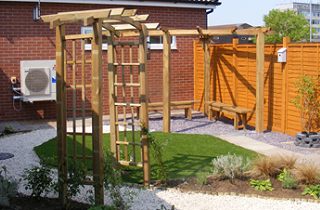Landscaping materials have evolved significantly over the years, reflecting advances in technology, changes in design preferences, and increased awareness of environmental impact. From traditional materials to modern innovations, the choice of materials plays a crucial role in shaping the aesthetic and functionality of outdoor spaces. Here’s a look at the evolution of landscaping materials and their impact on modern design.
Historically, landscaping materials were primarily natural and locally sourced. Stone, brick, wood, and gravel were commonly used for paths, walls, and other hardscaping elements. These materials were valued for their durability and availability, often reflecting the local geology and climate. For example, in coastal areas, sea stone and sand were prevalent, while in forested regions, timber and river rock were more common.
As landscaping design evolved, so did the materials used. The mid-20th century saw the rise of concrete and asphalt, which provided new possibilities for creating durable and cost-effective hardscaping features. Concrete allowed for more intricate designs and was widely used for patios, driveways, and walkways. However, these materials also had environmental drawbacks, including high energy consumption during production and limited permeability.
In recent decades, there has been a growing emphasis on sustainable and eco-friendly materials. The introduction of permeable paving systems marked a significant shift towards reducing stormwater runoff and promoting groundwater recharge. Permeable pavers, gravel, and permeable concrete allow rainwater to infiltrate the ground, minimizing erosion and improving water quality.
Recycled materials have also become increasingly popular in landscaping. Recycled glass, rubber, and metal are used to create visually appealing and environmentally friendly features. For example, recycled glass can be used for decorative aggregates or paving stones, while recycled rubber is often used for playground surfaces and garden paths. These materials help reduce waste and lower the environmental impact of landscaping projects.
The use of composite materials is another innovation in landscaping Nuneaton. Composite decking, made from a blend of wood fibers and plastic, offers the appearance of wood with enhanced durability and low maintenance. Composite materials are resistant to rot, insects, and weathering, making them a popular choice for decks, fences, and outdoor furniture.
Natural stone continues to be a favored material for its timeless beauty and durability. Advances in quarrying and processing techniques have made natural stone more accessible and versatile. New finishes, such as honed or brushed surfaces, provide a variety of aesthetic options, while innovative installation methods improve efficiency and reduce labor costs.
Another trend in landscaping materials is the integration of smart technologies. Smart irrigation systems use weather data and soil moisture sensors to optimize water usage, while LED lighting provides energy-efficient and customizable illumination. These technologies enhance the functionality of outdoor spaces and contribute to sustainable landscaping practices.
In addition to material innovations, there is a growing focus on creating cohesive and harmonious designs. Modern landscaping materials are chosen not only for their individual characteristics but also for how they complement other elements in the design. The combination of natural and engineered materials allows for creative and functional outdoor spaces that meet contemporary needs and preferences.
In conclusion, the evolution of landscaping materials reflects changes in design, technology, and environmental awareness. From traditional natural materials to modern eco-friendly innovations, the choice of materials plays a key role in creating beautiful, functional, and sustainable outdoor spaces.
